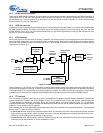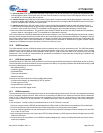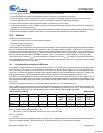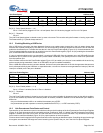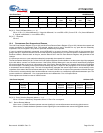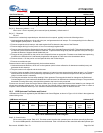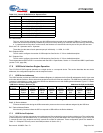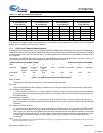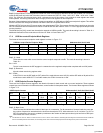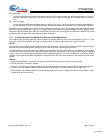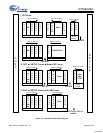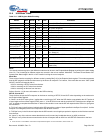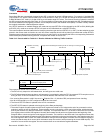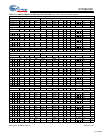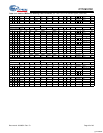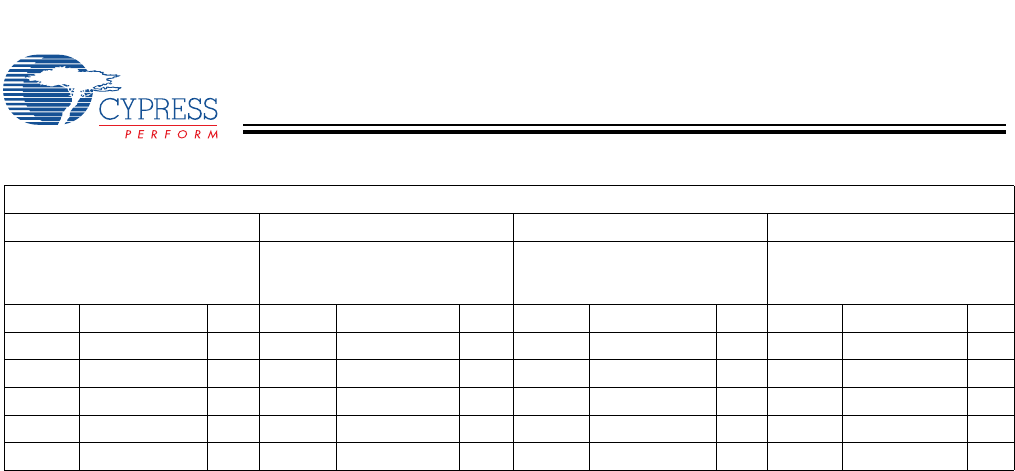
CY7C65113C
Document #: 38-08002 Rev. *D Page 35 of 49
When the SIE writes data to a FIFO, the internal data bus is driven by the SIE; not the CPU. This causes a short delay in the
CPU operation. The delay is three clock cycles per byte. For example, an 8-byte data write by the SIE to the FIFO generates a
delay of 2 µs (3 cycles/byte * 83.33 ns/cycle * 8 bytes).
17.3 USB Control Endpoint Mode Registers
All USB devices are required to have a control endpoint 0 (EPA0 and EPB0) that is used to initialize and control each USB address.
Endpoint 0 provides access to the device configuration information and allows generic USB status and control accesses. Endpoint
0 is bidirectional to both receive and transmit data. The other endpoints are unidirectional, but selectable by the user as IN or
OUT endpoints.
The endpoint mode registers are cleared during reset. When USB Status And Control Register Bits [6,7] are set to [0,0] or [1,0],
the endpoint zero EPA0 and EPB0 mode registers use the format shown in Figure 17-2.
Bits[3..0]: Mode.
These sets the mode which control how the control endpoint responds to traffic.
Bit 4: ACK.
This bit is set whenever the SIE engages in a transaction to the register’s endpoint that completes with an ACK packet.
Bit 5: Endpoint 0 OUT Received.
1 = Token received is an OUT token. 0 = Token received is not an OUT token. This bit is set by the SIE to report the type
of token received by the corresponding device address is an OUT token. The bit must be cleared by firmware as part of
the USB processing.
Bit 6: Endpoint 0 IN Received.
1 = Token received is an IN token. 0 = Token received is not an IN token. This bit is set by the SIE to report the type of
token received by the corresponding device address is an IN token. The bit must be cleared by firmware as part of the USB
processing.
Bit 7: Endpoint 0 SETUP Received.
1 = Token received is a SETUP token. 0 = Token received is not a SETUP token. This bit is set ONLY by the SIE to report
the type of token received by the corresponding device address is a SETUP token. Any write to this bit by the CPU will
clear it (set it to 0). The bit is forced HIGH from the start of the data packet phase of the SETUP transaction until the start
of the ACK packet returned by the SIE. The CPU should not clear this bit during this interval, and subsequently, until the
CPU first does an IORD to this endpoint 0 mode register. The bit must be cleared by firmware as part of the USB
processing.
[4]
Table 17-1. Memory Allocation for Endpoints
USB Status And Control Register (0x1F) Bits [7, 6]
[0,0] [1,0] [0,1] [1,1]
Two USB Addresses:
A (3 Endpoints) and
B (2 Endpoints)
Two USB Addresses:
A (3 Endpoints) and
B (2 Endpoints)
One USB Address:
A (5 Endpoints)
One USB Address:
A (5 Endpoints)
Label Start Address Size Label Start Address Size Label Start Address Size Label Start Address Size
EPB1 0xD8 8 EPB0 0xA8 8 EPA4 0xD8 8 EPA3 0xA8 8
EPB0 0xE0 8 EPB1 0xB0 8 EPA3 0xE0 8 EPA4 0xB0 8
EPA2 0xE8 8 EPA0 0xB8 8 EPA2 0xE8 8 EPA0 0xB8 8
EPA1 0xF0 8 EPA1 0xC0 32 EPA1 0xF0 8 EPA1 0xC0 32
EPA0 0xF8 8 EPA2 0xE0 32 EPA0 0xF8 8 EPA2 0xE0 32
USB Device Endpoint Zero Mode (A0, B0) Addresses 0x12(A0) and 0x42(B0)
Bit # 7 6 5 4 3 2 1 0
Bit Name Endpoint 0
SETUP
Received
Endpoint 0
IN
Received
Endpoint 0
OUT
Received
ACK Mode Bit 3 Mode Bit 2 Mode Bit 1 Mode Bit 0
Read/Write R/W R/W R/W R/W R/W R/W R/W R/W
Reset 0 0 0 0 0 0 0 0
Figure 17-2. USB Device Endpoint Zero Mode Registers
Note:
4. In 5-endpoint mode (USB Status And Control Register Bits [7,6] are set to [0,1] or [1,1]), Register 0x42 serves as non-control endpoint 3, and has the format for
non-control endpoints shown in Figure 17-3.
[+] Feedback



